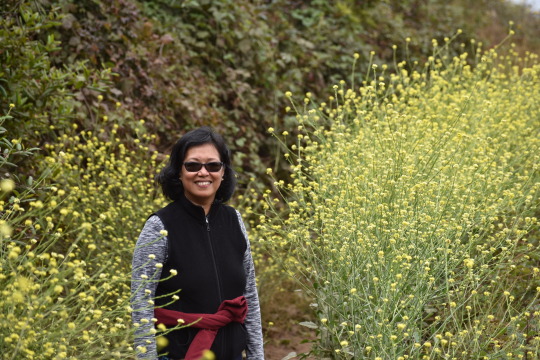By Denise Panaligan

A candid photo of the author’s mother.
In the beginning, they were in celebration. The room buzzed with anticipation. Doctor Aquino with her sanitized latex gloves at the edge of the bed coaxing and directing. The two assistants ready armed with umbilical cord scissors and blankets. Her father holding her mother’s hand like a prayer, beads of sweat trickling down his forehead. Her mother pushing, exerting, but mostly screaming until the baby came.
Anne at the edge of the room curious, terrified, and also hungry. She felt brave enough after a while to move closer to the edge of the bed and get a good look at the baby. Her father made a comment about how all babies looked strange at first, but Anne still had her doubts.
Eventually, celebration became mourning. The hemorrhage came suddenly, blood splattered on white sheets like a Jackson Pollock painting. What happened in the weeks that followed was a blur. Anne only caught bits and pieces of the scientific jargon: post-partum complications, hematocrit, cervix tear. Every word sounded like death. She had never seen her father cry before then. Watching him struggle to maintain composure, Anne refused to be alone with her thoughts.
Her mother, Tess, was one of those tragic beauty types. She was a brilliant financial analyst in the Philippines, first in her cohort and a proud member of the middle-class. She was full of her own power and vision of the world.
Moving to America with her husband, Tess could never get the language right. Despite this, she found a job as a secretary. She was hopeful about the success and happiness this new country could bring her. That was, until her immigration lawyer turned out to be a fraud. It was then that she no longer believed in ever getting the language right and grew quieter.
The quiet took Tess slowly. She had to depend on someone else for financial stability. Anne’s father found work as a day laborer but she had a harder time undocumented. Cleaning houses and doing other people’s laundry to survive took away any sense of accomplishment and self-respect she once had. But what really brought on the full effect of her silence was having to live in constant fear of being found.
“Nanay, how are you doing?” Anne asked as she sat by the couch next to the IV tubes. She came straight from school with calla lilies, her mother’s favorite.
Tess weakly opened her eyes.
“I just ate lunch. Still soup and mashed potatoes. How was school?”
“It’s okay. Finals are coming up soon…The doctor said you’re putting up a really good fight. If things go well, we can go home.”
Silence. Anne noticed the hum of the heart beat monitor in the background. She thought her mother had fallen asleep.
“Will you miss me when I’m gone? Am I better off dead?”
Anne felt physical pain as if her heart had crashed through wind chimes.
“What makes you say that?”
“This child has done more for our family by being born than I ever did for our family.”
“That’s not true. You gave birth to her. She wouldn’t be here without you.”
“So that’s it. I’m just the person who gave birth to a US citizen. Everything I worked hard for– gone. I used to be someone. I used to matter. I could go anywhere. Be anyone. I come to this godforsaken place and all I am is a breeder. My worth in life reduced to the one fact that I gave birth to someone more valuable than me.”
It was then that Anne felt for both her mother and her baby sister. Diana had no control over where she was born.
“You matter to me. You matter to Diana. You matter to Tatay. Why is that not enough for you? We love you. You love us. That’s why you have to fight to live Nanay.”
Mother and daughter looked at each other at that moment with understanding. With Diana, Anne thought, perhaps her mother could start telling stories again.
About the author: Denise Panaligan is currently in her last undergraduate year pursuing a
double major in Economics and Asian American Studies. She moved from the
Philippines at the age of 9, and only discovered about her immigration
status in high school. It was through her community involvement that she
understood the gravity of her parent’s sacrifice in leaving behind
everything to move and start over. She continues to focus on issues
immigration, access and affordability to
higher education, and researching on underrepresented groups,
specifically the Asian American community.
